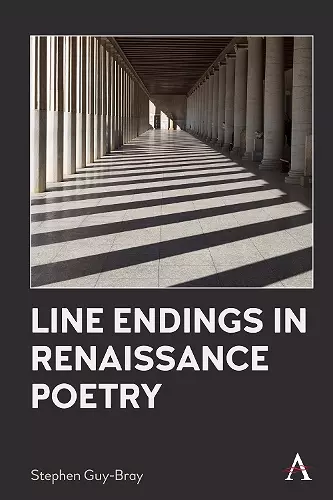Line Endings in Renaissance Poetry
Format:Hardback
Publisher:Anthem Press
Published:11th Oct '22
Should be back in stock very soon

Looks at how Renaissance poets ended their poetic lines and considers a range of strategies and argues that line endings are crucial to our understanding of the poems.
This book looks at how Renaissance poets ended their poetic lines. It considers a range of strategies and argues that line endings are crucial to our understanding of the poems.
This book looks at how Renaissance poets ended their poetic lines. It considers a range of strategies and argues that line endings are crucial to our understanding of the poems. It begins with an introduction summarizing the work that has already been done in this area and demonstrating the author’s own method. The main part of the book is divided into three chapters: one on rhyme; one on enjambment; and one on the sestina. These are the most significant kinds of line endings used by English Renaissance poets. The book ends with a brief afterword, wherein the author’s findings and some new areas for research are sketched out.
"Stephen Guy-Bray’s Line Endings in Renaissance Poetry promises to re-animate discussions of poetic form within English Renaissance studies and beyond. Guy-Bray masterfully details how attention to form can allow readers to tap into complex questions about the aural and visual components of language as it mediates and manipulates access to knowledge, desire and social hierarchy. Written with Guy-Bray’s characteristic elegance and wit, this book will be equally useful to undergraduates learning to read poetry, graduate students making their way into professional research and seasoned scholars who could stand to think more about poetry as poetry." —Melissa E. Sanchez, University of Pennsylvania, Pennsylvania.
"Elegantly constructed and attractively written, Guy-Bray’s book is a brilliant exposition of the aesthetics and significance of Renaissance poetic form." —Neil Rhodes, Professor of English, University St Andrews, Scotland.
"Stephen Guy-Bray is one of the finest contemporary critics of English Renaissance poetry currently writing. This is a wonderful book that reminds us vitally that form makes meaning, and that meaning is impossible without form. Guy-Bray’s intricate readings of how poetic lines end shed a fascinating light on the fundamental workings of poetry, both in the Renaissance and beyond." —Professor of Early Modern Literature University of Edinburgh, Scotland.
"Stephen Guy-Bray has written a delightful book about the line ending in early modern and the most modern of poetry– spry, yet attentive, both generous and mordant in its humour, and sprinkled with sentences and readings of a rare critical power." —Robert Stagg, The Shakespeare Institute / St Anne's College, Oxford.
"Guy-Bray’s close attention to the line-endings in renaissance poetry is consistently surprising, entertaining and above all enlightening. This study demonstrates how richly rewarding formalist analysis can be when matched with contemporary theoretical concerns, pointing us towards a new queer formalism." —Jim Ellis, Professor of English and Director of the Calgary Institute for the Humanities at the University of Calgary, and the author of The Poem, the Garden, and the World (Northwestern UP, 2023).
"Stephen Guy-Bray has written a charming book about line endings, the permeable boundaries of Renaissance poems. Inspired by Agamben’s remark that poetry must be graphic, Guy-Bray offers striking analyses of dozens and dozens of poems. A helpful book for any reader of poetry, and for any teacher of Renaissance poetry." —Christopher Warley, Professor, Department of English, University of Toronto, Canada.
ISBN: 9781785279096
Dimensions: 229mm x 153mm x 26mm
Weight: 454g
108 pages